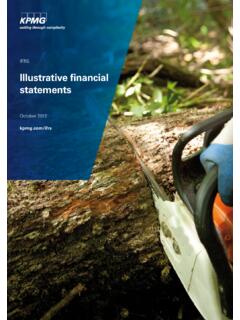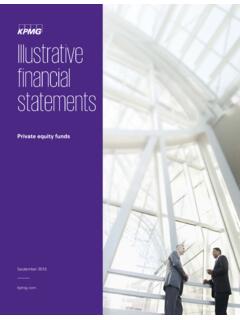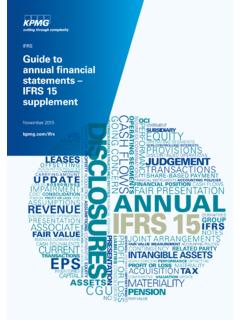Transcription of Outlook on the European DSO landscape 2020 - KPMG
1 Outlook ON THE European DSO landscape 2020 THE TRENDS THAT WILL CHANGE THE NAME OF YOUR GAME03 Preface 04 Changes in the DSO Environment 06 Changes in the DSO Role 08 Changes in the DSO ownership10 Changes in the DSO regulatory framework11 Conclusion14 Appendix Survey questions & results table2 / Vlerick Business School, Outlook on the European DSO landscape 2020 ACKNOWLEDGEMENTSWe gratefully acknowledge the contributions by Acea Distribuzione, Caruna, CREOS, DSO of Cyprus, , Hungary, Eandis, ED, EDP Distribui o Electrica, Electricity North West, Elektrilevi O , Enel Distributie Muntenia, Enel Distribuzione, Energa Operator, Enexis, ERDF, Estabanell Energia, EWE Netz, Hafslund Nett, HEDNO, Iberdrola Distribution, IKBAG, Infrax, Kraftringen N t, LESTO, Linz Strom Netz, M larenergi, Mitnetz Strom & Gas, Plauen Netz, Nurmij rven S hk verkko, ORES, PGE D, PREdistribuce, Rheinische NETZG esellschaft, Sadales tikls, SET Distribuzione, Sibelga, Sodo Elektro Ljubljana, Stedin, Stromnetz Hamburg, Sundsvall Eln t, Uni n Fenosa distribuci n, Vattenfall Distribution; the Belgian, Danish, Finnish & Swedish associations; and the 34 executives that chose to remain OF CONTENTS Vlerick Business School, Outlook on the European DSO landscape 2020 / 3 FUTURE OF DISTRIBUTION SYSTEM OPERATORS IN EUROPE S ENERGY SECTORPREFACEThe Vlerick Energy Centre is proud to present the results of our web-based survey on the future of Distribution System Operators (DSOs) in Europe s energy sector.
2 This research project launches the KPMG Research Chair at Vlerick Business School. The project has also been supported by the European sector organisations CEDEC, EDSO, Eurelectric, and GEODE, whom we thank for rallying support among their members and for challenging us to ensure the relevance of the research. In conducting the survey, we polled the views of 108 executives from no less than 24 countries on changes they foresee in the industry landscape by 2020. These executives represent up to 70% of European customers1. We also invited industry experts and thought leaders to give their take on our results so their views have also been included in the insights presented in this report encompass changes in the DSO environment, role, ownership and regulatory framework. FACILITATED BY IN PARTNERSHIP WITH 1 EDSO (the European Distribution System Operators Association for Smart Grids) represents up to 70% of European customers.
3 Most of the EDSO members participated in our survey, as well as many non-EDSO members. The web-based survey was conducted during the months of March and April :Pantone 36975 / 0 / 100 / 0blue:Pantone 286100 / 66 / 0 / 2 Thank you for your interest, and enjoy reading our report!Koen Tackx Professor of Management Practice Vlerick Business SchoolLeonardo MeeusAssociate Professor & Director Energy Centre Vlerick Business School4 / Vlerick Business School, Outlook on the European DSO landscape 2020 CHANGES IN THE DSO ENVIRONMENTThe liberalisation process at the end of the 20th century reformed the energy sector into competitive production and supply activities, and monopolistic transmission and distribution network activities. Distribution System Operators have a regulated mandate to own and operate the electricity distribution network in an area that ranges from a few streets up to the entire territory of a country.
4 This survey includes most of the large, and some of the smaller, companies of the more than 2300 DSOs in Europe. 60% of the participants in the survey serve more than 1 million customers, and 10% of the participants serve fewer than 100,000 customers. During the past century, large power generators (hydro, nuclear, coal and gas) generated electricity that was brought to consumers via a grid made of high-voltage transmission lines and cables that fed into a medium- and low-voltage distribution network. It was like a waterfall with electricity flowing in just one direction, from very high to progressively lower , this situation is changing rapidly. In addition to the large power plants, there are a whole range of renewable energy units like biomass stations, wind mills and photovoltaic panels and other smaller units, like cogeneration plants, that deliver both heat and electricity.
5 A whole raft of munici-palities, households and businesses own these smaller units, which generate electricity for local of such smaller units are already generating electricity all over Europe. 98% of our survey respondents think that the trend towards decentralised generation will continue2. These units generate electricity either as a by-product ( in the case of cogeneration) or in function of weather conditions ( in the case of solar and wind generators). As a result, matching supply with demand is becoming increasingly challenging. Whereas supply used to follow demand, demand is now expected to become more flexible to follow supply. 70% of the respondents predict that demand response will become mainstream by 2020 which will require a modernisation of the network infrastructure, including the way we measure and bill consumption.
6 72% believe that the EU s 80% rollout target for smart meters can be reached by believe that it will become common for customers to self-supply their demand and go off-grid by 2020. Indeed, the rapid development of batteries makes this a plausible future for customers that want to be energy-independent. In this regard, there are more believers in Eastern (46%) and Western (39%) Europe than in Northern (21%) and Southern (23%) Europe. In the open questions, many respondents cite batteries and electric vehicles as important drivers for change in the DSO response will become mainstream by 202037% Go off-grid by 2020EU s 80% rollout target for smart meters can be reached by 202037%2 Most questions were structured on a 6-point Likert scale, so that respondents had to take a position (remaining neutral was not an option).
7 However, we did include the option to remain anonymous, and 34 of the 108 executives that participated used this TAKE Vlerick Business School, Outlook on the European DSO landscape 2020 / 5 Not surprisingly, the respondents expect a fast-moving industry, with important changes in regulation (94%), innovation (86%), asset management (75%) and investment programmes (85%) in the DSO business. Larger operators, and operators that are privately owned, expect more changes in innovation than smaller operators and operators that are (partly) publicly 94%INNOVATION 86%ASSET MANAGEMENT 75%INVESTMENT PROGRAMMES 85%0100 GIAN CARLO SCARSI, HEAD OF THE DSO UNIT AT EURELECTRIC: This report on the future role of DSOs, as perceived by the very industry players at the core of the evolution process, provides powerful and sometimes surprising insights into what the perceived future challenges are.
8 This is not gazing into the crystal ball, but a reasoned overview of what industry experts see (or perhaps don t see) coming. A great and useful piece of information for industry, policy makers, and regulatory authorities. JEAN-MICHEL GLACHANT, DIRECTOR FLORENCE SCHOOL OF REGULATION: This excellent survey confirms that EU power systems are entering a fundamental revolution driven by distributed generation, prosumers, storage and interactive demand. Our DSOs aren t ostriches: they do see the storm. The question is: How will they act & react? GERT DE BLOCK, SECRETARY GENERAL CEDEC: These real-life experiences and visions of leading DSO experts reflect that the energy transition and the multi-utility model are here to stay, and that these experts are well aware of the strategy changes needed to optimise this (r)evolution.
9 However, a long-term vision, unambiguous energy and climate policy objectives at the EU and national levels, and the necessary transfor-mation of the regulatory framework are key to creating a stimulating environment that fosters effective and innovative investments by the DSO as market facilitator. RONNIE BELMANS, CEO ENERGYVILLE & EXECUTIVE DIRECTOR GLOBAL SMART GRID FEDERATION: The challenges stated here are just the beginning of a process of which we see only the tip of the iceberg. What will more electrification bring (EV, heat pumps)? Will local interactions between consumers be enabled ( direct energy exchange between buildings)? Will DSOs be limited to the wiring company business? CHANGES IN THE DSO ROLEDSOs are by definition asset-centric companies that manage electricity distribution infrastructure assets, such as electrical lines and cables, substations, and transformers.
10 45% of the operators also manage other networks: most commonly natural gas networks (39%), but also telecommunication networks (21%), even more than water networks (15%). Such multi-utility operators are much more common in Western Europe (79%). In our survey, 65% of the respondents believe that multi-utility is the future of the DSO business. This is more controversial among operators that currently focus on electricity than among operators that are already multi-utility among the latter, a very high 91% expect a multi-utility of the respondents expect that the investment level in the electricity DSO business will increase substantially by 2020. This explains why 94% see asset management as a core activity for generating value from their asset portfolio. Key asset management tools include asset databases (91%), total cost of ownership (88%), and asset management standards (82%).









